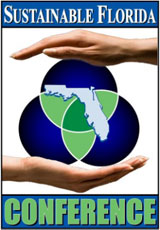
Georges Claude ~ 1929
 Harvesting thermal energy from the ocean traces its roots to 1881 when French physician Jacques-Arsène d’Arsonval first proposed using a heat engine based on the work of Scottish engineer William Rankine. D’Arsonval surmises that “if pumps pull enough water through two separate sets of pipes, the warm seawater will evaporate a heat transfer liquid (such as ammonia or propane) in one part of the plant; elsewhere, cold seawater recondenses the gas to liquid. But as it blows from the first point of phase change to the second, the gas stage will drive a turbine” (Chiles 2008). The physician, turned ocean scientist, knew that coastal areas close to deep cold water and warm surface water could produce power from the temperature difference. Harvesting thermal energy from the ocean traces its roots to 1881 when French physician Jacques-Arsène d’Arsonval first proposed using a heat engine based on the work of Scottish engineer William Rankine. D’Arsonval surmises that “if pumps pull enough water through two separate sets of pipes, the warm seawater will evaporate a heat transfer liquid (such as ammonia or propane) in one part of the plant; elsewhere, cold seawater recondenses the gas to liquid. But as it blows from the first point of phase change to the second, the gas stage will drive a turbine” (Chiles 2008). The physician, turned ocean scientist, knew that coastal areas close to deep cold water and warm surface water could produce power from the temperature difference.
In 1902, another innovator, named Willis Carrier, used Rankine’s heat engine principle in reverse for an air conditioning or cooling application. This system employed a working fluid (such as CFCs) to aid in removing heat from where it was objectionable (evaporator), using a compressor instead of a turbine to aid in the rejection of heat (condenser), to where it was not objectionable. This led to the application of the vapor compression cycle including the chilled water systems widely used in buildings and district cooling plants today.
A colleague of d’Arsonval, Georges Claude, was enthralled with the potential of ocean energy when, in 1929, he convinced Cuban dictator, Gerardo Machado, to build ocean thermal power plants that “could light up not only the entire island and its new industry but also deliver surplus power to Florida by undersea cable” (Chiles 2008). Matanzas Bay, Cuba was selected for its relatively close proximity to cold and warm water.
Mishap No. 1 – In August 1929, six foot diameter steel pipes in 70 foot sections were welded together and floated
out to sea on pontoons in three sections when a storm hit and sank most of the pipe.
Mishap No. 2 – In June 1930, a second attempt was made by building a long pipe on an adjacent river and dredging a cut in the sandbar that was separating the river from the sea. Cables from a tug boat would drag the long snake-like pipe out into the ocean. However, during the tugging operation, the pipe snagged and broke, sinking the pipe to the bottom of the bay.
Mishap No. 3 – Claude ordered more pipe from France, this time with a combination of
rail-cars on land launching onto pontoon boats. This attempt also ended in a complete loss of the pipe after the pontoon boats were not well coordinated.
Mishap No. 4 – Undaunted, Claude ordered more pipe but this time from his own account and now dwindling fortune. In September 1930, the pipe was laid successfully but not as deep as planned and consequently with lower temperature differential. The power plant ran for 11 days and produced enough power to light forty 500 watt light bulbs. Investors viewed this as too little return compared to the risk.
Mishap No. 5 – Claude’s last attempt at harvesting energy from the ocean was in the open sea off the coast of Brazil. Eight foot diameter pipes would be sunk vertically from a ship. A storm at sea during installation scuttled this project and ended Claude’s ocean energy dream and drained his fortune.

NELHA
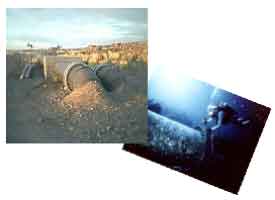 In 1974, the Natural Energy Laboratory of Hawaii (later named NELHA) was established by the State of Hawaii legislature on a 322 acre area at Keahole Point on the Big Island as a support facility for Ocean Thermal Energy Conversion (OTEC) research. If successful, NELHA would “prove the feasibility and usefulness of OTEC as an alternative non-polluting power source” (“Deep,” 2010). In 1979, the first successful project was an at-sea, closed-cycle OTEC operation conducted aboard the Mini-OTEC, a converted Navy barge operating in waters off Keahole Point, Hawaii. In 1974, the Natural Energy Laboratory of Hawaii (later named NELHA) was established by the State of Hawaii legislature on a 322 acre area at Keahole Point on the Big Island as a support facility for Ocean Thermal Energy Conversion (OTEC) research. If successful, NELHA would “prove the feasibility and usefulness of OTEC as an alternative non-polluting power source” (“Deep,” 2010). In 1979, the first successful project was an at-sea, closed-cycle OTEC operation conducted aboard the Mini-OTEC, a converted Navy barge operating in waters off Keahole Point, Hawaii.
Click to read more...

The Purdy’s Wharf Complex in Halifax, Nova Scotia
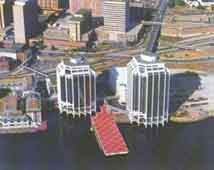 "In Halifax an innovative cooling system at the Purdy’s Wharf office and commercial complex uses low temperature seawater to meet building cooling requirements. Cold seawater is drawn from the harbour floor, circulated through titanium heat exchangers in the basement of the Wharf building, and then returned to the ocean floor" ("Seawater," 1992). "In Halifax an innovative cooling system at the Purdy’s Wharf office and commercial complex uses low temperature seawater to meet building cooling requirements. Cold seawater is drawn from the harbour floor, circulated through titanium heat exchangers in the basement of the Wharf building, and then returned to the ocean floor" ("Seawater," 1992).
Click to link to full article...

Cornell University
 Nearly a century after Dr. Carrier’s invention changed the world, his alma mater, Cornell University, has followed suit with a Lake Source Cooling System that provides roughly 18,000 to 20,000 tons of cooling (“About,” 2006). For a decade now, the Cornell campus has been cooled with 39°F water from the adjacent Lake Cayuga. The previous mechanical chiller plant at Cornell in 1999 was operating at .83 IkW/ton. The new plant is now operating at 0.1 IkW/ton or 86% less electricity, thereby providing significant savings in fuel expense and avoiding carbon emissions at the power plant. Nearly a century after Dr. Carrier’s invention changed the world, his alma mater, Cornell University, has followed suit with a Lake Source Cooling System that provides roughly 18,000 to 20,000 tons of cooling (“About,” 2006). For a decade now, the Cornell campus has been cooled with 39°F water from the adjacent Lake Cayuga. The previous mechanical chiller plant at Cornell in 1999 was operating at .83 IkW/ton. The new plant is now operating at 0.1 IkW/ton or 86% less electricity, thereby providing significant savings in fuel expense and avoiding carbon emissions at the power plant.
Click to link to full article...

The InterContinental Hotel, Bora Bora
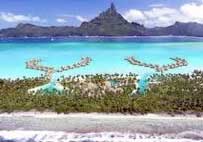 The InterContinental Hotel in Bora Bora, of the Leeward Islands in French Polynesia, is cooled by deep seawater proving 90% savings over an electric chilled water system. "This luxurious eco hotel boasts the first thelaso spa in the southern hemisphere and is the very first hotel in the world to be entirely air conditioned with cold water drawn from the ocean depths." The InterContinental Hotel in Bora Bora, of the Leeward Islands in French Polynesia, is cooled by deep seawater proving 90% savings over an electric chilled water system. "This luxurious eco hotel boasts the first thelaso spa in the southern hemisphere and is the very first hotel in the world to be entirely air conditioned with cold water drawn from the ocean depths."
Click to watch this short video...

Enwave District Cooling Project, Toronto
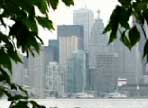 Taking the current lead in hydrothermal cooling, the Enwave District Cooling project in Toronto provides roughly 59,000 tons of cooling from 4°C (39°F) water from the deep water of neighboring Lake Ontario (“Enwave,” 2010). The project final cost was approximately $128 million dollars but one of the key return on investment strategies was to dual purpose the water not only for cooling but also for pure drinking water. The Toronto Lake Source District Cooling project connected 3 sections of 2 kilometer long pipe and floated the 6000 meters of piping onto Lake Ontario as seen in Figure 2. To submerge the piping, they employed a controlled submergence technique developed by Joe Van Rysin and his team at Makai Engineering, Hawaii. As seen in the project documentary, during the installation, the wind picked up suddenly and the vast pipeline on the surface precariously flexed as a snake. The pipe was successfully submerged but there was speculation that a further increase in wind velocity and the pipe might have snapped and been lost to the bottom. Sounding eerily similar to the misfortunes of Georges Claude, this near miss has once again indicated the need to have a more robust solution in deploying pipes to access water. Taking the current lead in hydrothermal cooling, the Enwave District Cooling project in Toronto provides roughly 59,000 tons of cooling from 4°C (39°F) water from the deep water of neighboring Lake Ontario (“Enwave,” 2010). The project final cost was approximately $128 million dollars but one of the key return on investment strategies was to dual purpose the water not only for cooling but also for pure drinking water. The Toronto Lake Source District Cooling project connected 3 sections of 2 kilometer long pipe and floated the 6000 meters of piping onto Lake Ontario as seen in Figure 2. To submerge the piping, they employed a controlled submergence technique developed by Joe Van Rysin and his team at Makai Engineering, Hawaii. As seen in the project documentary, during the installation, the wind picked up suddenly and the vast pipeline on the surface precariously flexed as a snake. The pipe was successfully submerged but there was speculation that a further increase in wind velocity and the pipe might have snapped and been lost to the bottom. Sounding eerily similar to the misfortunes of Georges Claude, this near miss has once again indicated the need to have a more robust solution in deploying pipes to access water.
>Click to watch this short video...

|

 Harvesting thermal energy from the ocean traces its roots to 1881 when French physician Jacques-Arsène d’Arsonval first proposed using a heat engine based on the work of Scottish engineer William Rankine. D’Arsonval surmises that “if pumps pull enough water through two separate sets of pipes, the warm seawater will evaporate a heat transfer liquid (such as ammonia or propane) in one part of the plant; elsewhere, cold seawater recondenses the gas to liquid. But as it blows from the first point of phase change to the second, the gas stage will drive a turbine”
Harvesting thermal energy from the ocean traces its roots to 1881 when French physician Jacques-Arsène d’Arsonval first proposed using a heat engine based on the work of Scottish engineer William Rankine. D’Arsonval surmises that “if pumps pull enough water through two separate sets of pipes, the warm seawater will evaporate a heat transfer liquid (such as ammonia or propane) in one part of the plant; elsewhere, cold seawater recondenses the gas to liquid. But as it blows from the first point of phase change to the second, the gas stage will drive a turbine”  In 1974, the Natural Energy Laboratory of Hawaii (later named NELHA) was established by the State of Hawaii legislature on a 322 acre area at Keahole Point on the Big Island as a support facility for Ocean Thermal Energy Conversion (OTEC) research. If successful, NELHA would “prove the feasibility and usefulness of OTEC as an alternative non-polluting power source”
In 1974, the Natural Energy Laboratory of Hawaii (later named NELHA) was established by the State of Hawaii legislature on a 322 acre area at Keahole Point on the Big Island as a support facility for Ocean Thermal Energy Conversion (OTEC) research. If successful, NELHA would “prove the feasibility and usefulness of OTEC as an alternative non-polluting power source”  "In Halifax an innovative cooling system at the Purdy’s Wharf office and commercial complex uses low temperature seawater to meet building cooling requirements. Cold seawater is drawn from the harbour floor, circulated through titanium heat exchangers in the basement of the Wharf building, and then returned to the ocean floor" ("Seawater," 1992).
"In Halifax an innovative cooling system at the Purdy’s Wharf office and commercial complex uses low temperature seawater to meet building cooling requirements. Cold seawater is drawn from the harbour floor, circulated through titanium heat exchangers in the basement of the Wharf building, and then returned to the ocean floor" ("Seawater," 1992). Nearly a century after Dr. Carrier’s invention changed the world, his alma mater, Cornell University, has followed suit with a Lake Source Cooling System that provides roughly 18,000 to 20,000 tons of cooling (“About,” 2006). For a decade now, the Cornell campus has been cooled with 39°F water from the adjacent Lake Cayuga. The previous mechanical chiller plant at Cornell in 1999 was operating at .83 IkW/ton. The new plant is now operating at 0.1 IkW/ton or 86% less electricity, thereby providing significant savings in fuel expense and avoiding carbon emissions at the power plant.
Nearly a century after Dr. Carrier’s invention changed the world, his alma mater, Cornell University, has followed suit with a Lake Source Cooling System that provides roughly 18,000 to 20,000 tons of cooling (“About,” 2006). For a decade now, the Cornell campus has been cooled with 39°F water from the adjacent Lake Cayuga. The previous mechanical chiller plant at Cornell in 1999 was operating at .83 IkW/ton. The new plant is now operating at 0.1 IkW/ton or 86% less electricity, thereby providing significant savings in fuel expense and avoiding carbon emissions at the power plant.  The InterContinental Hotel in Bora Bora, of the Leeward Islands in French Polynesia, is cooled by deep seawater proving 90% savings over an electric chilled water system. "This luxurious eco hotel boasts the first thelaso spa in the southern hemisphere and is the very first hotel in the world to be entirely air conditioned with cold water drawn from the ocean depths."
The InterContinental Hotel in Bora Bora, of the Leeward Islands in French Polynesia, is cooled by deep seawater proving 90% savings over an electric chilled water system. "This luxurious eco hotel boasts the first thelaso spa in the southern hemisphere and is the very first hotel in the world to be entirely air conditioned with cold water drawn from the ocean depths."  Taking the current lead in hydrothermal cooling, the Enwave District Cooling project in Toronto provides roughly 59,000 tons of cooling from 4°C (39°F) water from the deep water of neighboring Lake Ontario
Taking the current lead in hydrothermal cooling, the Enwave District Cooling project in Toronto provides roughly 59,000 tons of cooling from 4°C (39°F) water from the deep water of neighboring Lake Ontario 


